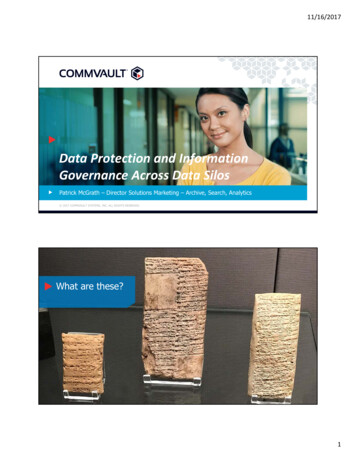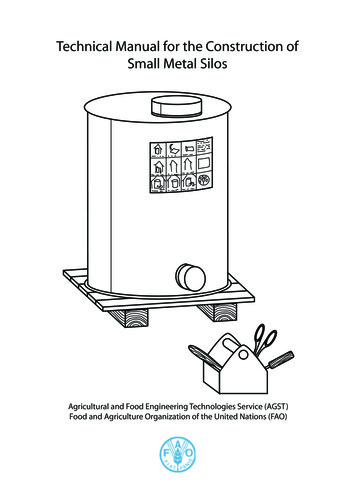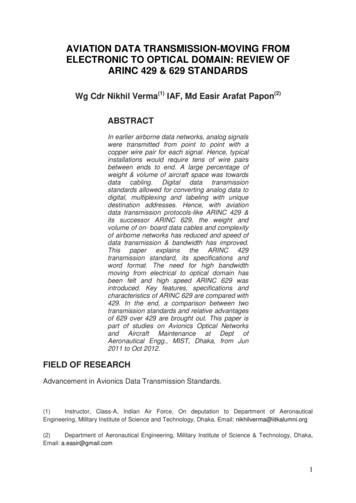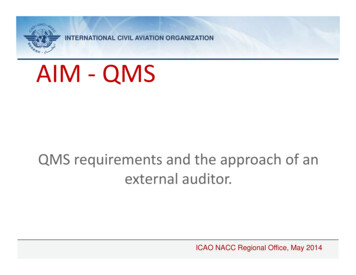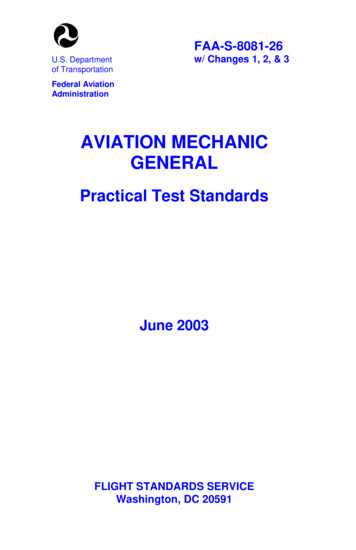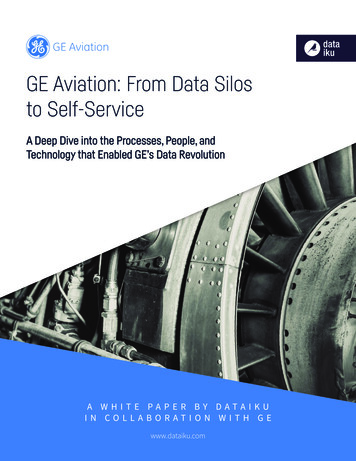
Transcription
GE Aviation: From Data Silosto Self-ServiceA Deep Dive into the Processes, People, andTechnology that Enabled GE’s Data RevolutionA WHITE PAPER BY DATAIKUIN COLLABORATION WITH GEwww.dataiku.com
1 2020 Dataiku, Inc. www.dataiku.com contact@dataiku.com @dataiku
IntroductionAny company that wants to make any impactful change today - whether that’s decreasing costsor risks, increasing revenue, creating innovative new products, or making employees and theorganization more efficient overall - has the opportunity to do so using today’s not-so-secretweapon: data.According to Forbes 1, in 2018, humans and their systems produce around 2.5 quintillion bytesof data a day (by the way, a quintillion is 1018). Most of this data lies in the hands of companies,and the ones that are able to make radical business change today are those able to harnessmassive amounts of data and turn it into insights at scale.This is easier said than done - transformation at this level doesn’t simply mean slapping dataon top of existing processes; it involves fundamental organizational change, weaving data intothe very fabric of the company. To date, despite the hype around artificial intelligence (AI) inthe media, very few businesses have managed to execute on incorporating the fundamentalmachine learning (ML) processes that enable these data insights at scale, much less automatingthem to enable AI services.This white paper tells the story of GE Aviation, a company that bucks this trend and that has, ata large scale, been able to empower the organization - not just at a high-level, but down to theindividual level - to use data for day-to-day processes. Specifically, it will cover: How GE Aviation developed a self-service data program using Dataiku and a suiteof tools that unlocks employees’ ability to use data to get insights quickly. The technological stack and organizational setup at GE Aviation that enable these systems. The lifecycle of a data product at GE Aviation. How GE Aviation handles data governance and data education (including suggestions foremployee onboarding material for a self-service data system). The return on investment (ROI) GE Aviation has seen from their data initiatives. 2020 Dataiku, Inc. www.dataiku.com contact@dataiku.com @dataiku2
Fast FactsSubsidiary ofGeneral ElectricHeadquarters:Evendale, Ohio(United States)Industry:Aerospace40,000total employees3 2020 Dataiku, Inc. www.dataiku.com contact@dataiku.com @dataiku
1,841 users* ofthe self-serviceanalytics system*includes true users, i.e., excludes IT team members or other administrative functions2,000 data productscreated since March2017130 published datasetsin the last year218 projects in Dataikuautomation(plus 450 more automated functions in Starfish) 2020 Dataiku, Inc. www.dataiku.com contact@dataiku.com @dataiku4
Key ContributorsSelf-Service Analytics at GE AviationS O MESHS A XENA2“Is the Product Owner of Dataiku and Alation at General Electric Aviation. He managesa team of full-stack data engineers and helps lead the Self-Service Data Program.Somesh supports a community of over 1,400 self-service developers building digitalproducts to make data-driven decisions.Somesh has trained over 700 employees through the Digital Data Analyst training,which teaches digital tools, data science, and process excellence. Somesh is front andcenter of the digital cultural transformation at General Electric Aviation. He beganhis career with General Electric’s Digital Technology Leadership Program exploringdifferent areas of the business. He led projects for the company’s customer portal; didfull-stack web development in Cyber Security; and data ingestion, engineering, andvisualization in the data analytics space.“Somesh is a Certified Scrum Product Owner from the Scrum Alliance. Somesh holds adegree in Business Administration with a concentration in Information Systems fromthe University of Cincinnati.5 2020 Dataiku, Inc. www.dataiku.com contact@dataiku.com @dataiku
JONT U DOR3“is the Senior Manager of Self-Service Data Engineering and Analytics at General ElectricAviation. He founded the Self-Service Data Program in 2016 and now leads the team,implementing six innovative products that enable over 1,500 users to create their owndata and analytics solutions. Joining GE Aviation in 2009 as an intern, he completedthe Information Technology Leadership Program in 2014, and has since held rolesspanning data ingestion, big data architecture, cloud application automation, andself-service data and analytics.Jon graduated with a BS in Business, majoring in Management Information Systems,from Miami University in 2012 with Magna Cum Laude and Honors. He’s always happy“to connect with others interested in digital transformation through data and analytics,so feel free to reach out on LinkedIn! 2020 Dataiku, Inc. www.dataiku.com contact@dataiku.com @dataiku6
Self-ServiceAnalytics atGE Aviation:So MuchMore than BI7Sometimes when people think of self-But today, self-service can be (and is) soservice analytics, they often still thinkmuch more than that, and that’s especiallyof old-school business intelligence (BI),true at GE Aviation. In a general sense,which is often extremely limited onlyself-service is the system by which line-to historical data. On top of that, it canof-business professionals or analysts cangenerally only be used to create ratheraccess and work with data to generatestatic dashboards that ultimately don’tinsights (predictive or not) as well asprovide much utility to the business as adata visualization with little directwhole. In fact, just a few years back (circasupport from data scientists, IT, or a2015) 4, industry leaders and analysts werelarger data team (though the self-servicestill hailing BI platforms as the end-all-be-platform itself should be supported byall of data-driven transformation.these personas). 2020 Dataiku, Inc. www.dataiku.com contact@dataiku.com @dataiku
“More than 87 percent of organizations are classifiedas having low business intelligence (BI) and analyticsmaturity, according to a survey by Gartner, Inc. Thiscreates a big obstacle for organizations wanting toincrease the value of their data assets and exploitemerging analytics technologies such as machinelearning.”Gartner Press Release, Gartner Data Shows 87 Percent of OrganizationsHave Low BI and Analytics Maturity, December - 2018, 5
And indeed, GE Aviation has implemented their own version of aself-service system that serves their specific needs andrequirements and that allow them to use real-time data at scaleto make better and faster decisions throughout the organization: Engineering is using data from these tools to redesign parts and build jet engines moreefficiently. Supply chain is using it to get better data insights into their shop floors and streamline supplychain processes. Finance is using it to understand key metrics such as cost, cash, etc. The commercial group (by leveraging data scientists) is using these tools to transform enginesensor data from customers and build analytics services for them. The data initiative at GE Aviation is called Self-Service Data (SSD), but in fact encompassesboth self-service in the traditional sense as well as an element of operationalization 6 (thatis, the process of converting data insights into actual large-scale business and operationalimpact) for both business lines and IT users.The SSD at GE Aviation is, in a nutshell: The ability for everyone (with proper access rights) to discover and use data, prepare that data,and create a data product, including developing predictive models within Dataiku. The ability for data product creators to share their work with other colleagues. The ability for data product creators to deploy data pipelines in production using macrosdeveloped in Dataiku.Ultimately, the teams at GE Aviation have developed the SSD in such a way that anything userswant to put in production, they can - provided it passes a set of checks and balances to ensure itmeets database administration and data governance standards. They were able to do this throughthe way they chose and configured technology and their Dataiku instance, but equally important,how they built organizations around the initiative for support.9 2020 Dataiku, Inc. www.dataiku.com contact@dataiku.com @dataiku
But it wasn’talways thisway.
The History ofSelf-ServiceData at GE &The DigitalLeagueSomeone on the business side is responsibleThe business user does his or her best with thatfor giving numbers to leadership. One day,Excel extract, comparing that data to similarthey need to deliver something specific to thedata from past reports or to others’ data extractsleadership team, so they go to IT and ask for ato try to figure out if it’s the right data and if it’sreport or a dataset. The IT team gives them anaccurate. He or she then puts together a reportextract of data in Excel.in PowerPoint for the leadership team. Rinseand repeat about once a month.SOUND FAMILIAR ?11 2020 Dataiku, Inc. www.dataiku.com contact@dataiku.com @dataiku
Until 2015, this was the process of using data at GE Aviation as well. Following thisprocess, they moved on to building reports (either weekly or monthly) in Spotfire,with the deliverable to leadership being screenshots of Spotfire - still delivered inPowerPoint.But they still had trouble scaling these efforts not justbecause of a technological barrier, but also because of: Lack of trust and transparency: With limited visibility into how the datawas being processed or where it was coming from, leadership wouldquestion the data (or the logic behind it). And there was no easy answer tothese concerns - when people questioned data, there was no real source oftruth. This undermined all of the efforts put forth by the business teams. Silos: Not only was data siloed, but individual business users also eachhad their own dashboards (there was no shared, central repository). Repetitive Efforts: Because of the aforementioned silos, by nature, lotsof efforts ended up getting repeated over and over again. Business usersdidn’t have any visibility into projects and analysis that had already beendone, which caused a lot of time to be lost. No central vision: Ultimately, the company didn’t have one overarchingidea or standard for using data, and with a lack of vision, no one individualbusiness user, much less an entire line of business, could really moveforward and execute properly.“The Digital League completely transformedthe culture of data at GE Aviation.”-Somesh Saxena 2020 Dataiku, Inc. www.dataiku.com contact@dataiku.com @dataiku12
GE Aviation’s data revolution began in 2016one physical location. Their goal was to createwhen they built The Digital League, a cross-data-driven products, and from the time offunctional team (made up of leaders fromtheir creation on, anything data-related wentsupply chain, finance, IT, and engineering linesthrough this team.of business) that came together under onecentral vision and strategy and, importantly, inThe Digital League worked to spark the digital datarevolution at GE Aviation because it: Broke down silos: The team established itself as the principal place that controlled alldata initiatives, and this helped ensure a central vision and necessary control over dataprocesses. When getting started, the idea and practicalities of having one team owningthe initiative was critical. Emphasized communication and collaboration: The Digital League was a culturalrevolution - normally, these lines of business (supply chain, finance, IT, and engineering)sat physically in different buildings, communicating almost entirely through email.Having them together meant that they actually fundamentally worked together, eachintimately understanding the role of the others through regular demo days and Agilemethodology where all representatives were present at daily standups. Drove infrastructure decisions: In addition to driving data culture, The Digital Leaguealso drove data infrastructure decisions (specifically building a data lake) that set thestage for future innovations. Having one common repository and the data all in oneplace made a huge difference into changing GE Aviation’s data initiatives into what theyare today.13 2020 Dataiku, Inc. www.dataiku.com contact@dataiku.com @dataiku
The Birthof SSD:Technological &OrganizationalSetupFollowing the successful launch of The Digitalbringing data into the hands of everyone atLeague and its growth over the year afterthe organization in addition to providing thefounding, the SSD initiative was born in latecentral vision and infrastructure. Out of this2016 out of the need to provide scale to dataneed, the SSD was born. And today, 90 percentinitiatives beyond the Digital League. That is,of the users of the SSD are outside of TheGE Aviation needed to start democratizing:Digital League.HOW DID GE AVIATIONGET THERE ?operationalization, etc.). All of these issuesSelf-service initiatives often fail in largelaunched, then forgotten.At GE Aviation, this isboil down to a larger problem: self-serviceenterprises for a variety of reasons (ongoingissues with data access, insufficient tooling or tooling that doesn’t meet users’ daily needs,lack of data accuracy or data confidence,data security problems, a complete lackof15connectionbetweenself-serviceandgets treated as a one-time project that getsfar from the reality - they view their self-serviceinitiative as an ongoing one that requiressupport and continuous improvement to findcontinual success. Therefore, there are twoteams at GE Aviation that support their robustself-service initiative: 2020 Dataiku, Inc. www.dataiku.com contact@dataiku.com @dataiku
1TTHE SELF-SERVICE DATA TEAM,WHO ARE RESPONSIBLE FOR User enablement - training and best practice documentation (more on this later). Tool administration (including Dataiku), instance sizing, and usage monitoring. New process development and identification of opportunities for process automation. Ensuring the smooth deployment of data products.he team supports over 1,800 users today.They are a centralized group based at thecompany’s office in Cincinnati, but theywork to support users around the globe. Thisteam ensures that nothing is blocking peoplefrom using SSD, whether that be an initialknowledge gap or technical issues along theway. That means teaching users to do thingsfor themselves instead of simply acting as amore traditional help team who takes ticketsand solves issues on behalf of the users.Importantly, they also ensure that theinitiative keeps its momentum - that is, thatit doesn’t become outdated or stale andcontinues to evolve with the needs of thebusiness and the users - by introducing newautomations and process improvements to 2020 Dataiku, Inc. www.dataiku.com contact@dataiku.com @dataikureduce repetitive work across the board.For example, the team recently turned therather arduous process of triggering dataproduct deployment (which involved manuallyswitching the product’s environment, makingsure any scenarios were turned on and runningmanual checks on those scenarios, etc.) intoan automated process so that macros do allof these checks behind the scenes and userscan simply automate their data product witha click of a button in Dataiku.This allows users a more instant satisfactionof deployment to production, plus the SelfService Data Team can spend more time onother priorities, like supporting any issues inproduction and improving education aroundthe tools and processes.16
2 THE DATABASE ADMIN TEAM,WHO ARE RESPONSIBLE FOR:Ensuring that data products going into production follow basic datagovernance policies, including naming conventions and data access rules. Checking that any data used in deployed self-service projects are beingused appropriately. Along with the Self Service Data Team, helping with user support in caseof any failures in deployed projects (e.g., data logic changes, etc.).It’s worth noting that neither of thesetheir needs are.two teams is responsible for evaluatingThe job of the Self-Service Data andthe self service users’ projects from theDatabase Admin Teams is simply toperspective of business need or businessenable them to do what they need touse case. That’s because in the case ofwith the data and ensure there are noGE Aviation, those users are the businesstechnical roadblocks to using that data.experts - they know best about whatFrom a technical standpoint, the structure that enablesthese two teams to function and to support the SSDand its users consists of: Greenplum and Hortonworks/HIVE (for database management) Dataiku (for designing and deploying data products - users access, clean,and manipulate data through Dataiku) Alation (for data cataloging and search) Daasboard (an in-house tool built for monitoring the state and status ofall data products) Spotfire (visualization of final data product for end business users) Starfish (an in-house tool built to enable automation of database functionsand ingestion of data to the data lake) Published Data (reusable business domain data to act as a starting placefor data exploration)17 2020 Dataiku, Inc. www.dataiku.com contact@dataiku.com @dataiku
“SSD at GE Aviation was born out of a conversation ina conference room. The idea was that you would neverbe able to hire enough data professionals to meetthe data demands of the business, so instead, why notturn the business into data professionals. Takingthat premise we started to define what self-servicemeant for us and how it would work. ”-Jon Tudor
The TwoProngsof DataEnablementToday, the SSD and The Digital League bothat GE Aviation, managing larger initiativesexist in parallel at GE Aviation - that is, thethat touch multiple parts of the business asdevelopment of a self-serve solution did notsort of a top-down strategy that rounds outeliminate the need for The Digital League. Inthe SSD’s bottom-up approach.fact, The Digital League continues to be a vitalpiece of the overall digital and data strategy19 2020 Dataiku, Inc. www.dataiku.com contact@dataiku.com @dataiku
“The Digital League is the cultural piece [of thedata-driven approach] – people are impressed thatwe have that in a 127-year-old company. It takes alot to innovate, and The Digital League is enablingthat; they are the next step in the innovation ofmanufacturing.”-Somesh SaxenaThe Digital League, for example, might(help with data engineering, guidancehave five key metrics or objectives theyon projects, etc.) to simple tools accessare focused on in a given year. Therethat the SSD will provide.might be other metrics or data initiativesAnd sometimes it works in the oppositethat are also important, and the SSD willdirection as well - the SSD mightwork on enabling and supporting thosesupport a data project for a particularin other teams and departments aroundteam that becomes a larger priority forthe company. The support providedthe company, in which case it would beranges from more full-service supporttaken over by The Digital League. 2020 Dataiku, Inc. www.dataiku.com contact@dataiku.com @dataiku20
The DataProduct & ItsLifecycle atGE AviationAt GE Aviation, a data product generallydashboards - which are far from the well-consists of a dashboard that is consumedknown, static, BI-sense of the word - provideby users in the business units where data isautomated information flows powered bycoming in and updated in batches - weekly orDataiku on critical business functions (seedaily (as opposed to a dashboard that looksthe next section for specific use cases).at or shows historical data). These so-called21 2020 Dataiku, Inc. www.dataiku.com contact@dataiku.com @dataiku
But how does an employee in a line of businessdepartment at GE Aviation go from idea to raw datato business-impacting data flows?1DATASETS ARE READILY AVAILABLE TO THOSEWITH APPR
is the Senior Manager of Self-Service Data Engineering and Analytics at General Electric Aviation. He founded the Self-Service Data Program in 2016 and now leads the team, implementing six innovative products that enable over 1,500 users to create their own data and analytics solution
